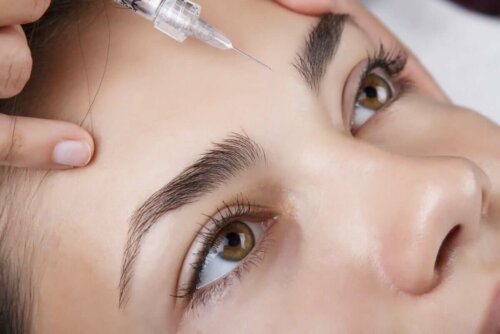What Are the Side Effects of Hyaluronic Acid?


Written and verified by the dermatologist Maria del Carmen Hernandez
Recently, there’s been talk about the side effects of hyaluronic acid everywhere. This is because it’s one of the most appreciated products for skin regeneration. This substance adds volume to those areas where certain tissues have become too thin. Its employment in the field of beauty and personal care continues to increase.
The person receiving the substance must be aware of certain guidelines in order to avoid adverse reactions and to obtain optimal results. Continue reading to find out some recommendations as to what to avoid.
Side effects of hyaluronic acid
After the application of hyaluronic acid, you must follow a series of indications in order to avoid side effects. These reactions aren’t always a direct consequence of the product but also appear when a patient doesn’t follow the professional instructions.
Redness of the area
Erythema, a side effect of hyaluronic acid, is caused by the same trauma as local injections. It also depends on the properties of the product used though. This symptom manifests as temporary redness with slight inflammation.
It usually lasts from hours to 2 days but you can speed up the healing process and use special creams after a session to stimulate healing.

Bruising due to hyaluronic acid
This is usually expected along with some inflammation and shouldn’t last more than a few days. Apply firm pressure and ice packs before, after, or during the session in order to minimize both of these adverse effects.
Discontinue the use of unnecessary anticoagulant drugs or products you may be consuming. According to a study published in The Journal of Clinical and Aesthetic Dermatology, the incidence of bruising after dermal fillers is between 19 and 24%.
Read about the Seven Benefits of Taking Collagen Daily
Asymmetry
The amount of hyaluronic acid can lead to asymmetry. That is a momentary discrepancy in the volume of the face on each side of the nose — one area is larger than the other.
Allergic reactions and hypersensitivity
These reactions are rare, as hyaluronic acid is a biocompatible product — the body assimilates it without identifying it as an external agent. This is because its components are similar to natural body substances. Any allergies would manifest as local irritation.
Skin necrosis
Cutaneous necrosis, due to compression or obstruction of a blood vessel, is a rare complication. The place of greatest risk for this to happen is between the eyebrows. This is because this region is supplied by the supratrochlear artery, which doesn’t have a strong collateral circulation. Thus, it cannot receive blood from another place.
Plastic and Reconstructive Surgery recommends aspiration with a needle in a constant back and forth motion before injecting the filler. This could prevent this kind of complication.
Short-term hyaluronic acid side effects
Some side effects of hyaluronic acid, like the ones mentioned above, appear in the short term but not immediately. This means they manifest a few days after the application.
Palpable or visible nodules
Nodules and lumps are common complications that result from the use of dermal fillers. They’re classified as inflammatory or non-inflammatory. Late-onset nodules that last from 4 weeks to 1 year or more are often inflammatory immune responses to hyaluronic acid.
According to the American Journal of Clinical Dermatology, inflammatory nodules are more common with permanent fillings. However, there are also reports of their development after the use of temporary fillings.
Hyaluronic acid activates the herpes simplex virus
The technician in charge must do a prophylactic anti-herpetic treatment when doing an intervention in the lip area of people with herpes. This is because one of the side effects of hyaluronic acid is the activation of this infection, usually lodged in the nerves of the face.
Check out the Five Symptoms of Aging On Your Neck and How to Reverse It
Long-term side effects of hyaluronic acid
There may be long term complications months or years from the application of hyaluronic acid. However, these are usually misdiagnosed due to the intervening time. Thus, it’s hard to use them in reference to this kind of treatment.
Granulomas
A granulomatous foreign body reaction could develop several years after this kind of injection. This process is either asymptomatic or accompanied by erythema and swelling.
You can treat persistent foreign body reactions with intralesional corticosteroid injections. However, the American Society for Dermatologic Surgery, through studies, positions hyaluronidase as a feasible therapy for this unwanted effect.

Product migration
The migration of hyaluronic acid is one of the possible complications associated with the injection of soft tissue fillers. Thus, take into account that the applied substance can migrate to a place far from the injection site, as well as remain in the tissue years later when evaluating nodules, masses, or swelling on the face.
The importance of going to a professional
There are many strategies to decrease the risks of complications from hyaluronic acid fillers. Proper working knowledge of the side effects by a professional is essential.
Unwanted reactions are rare when using the right injection technique. However, people must be aware that unforeseen adverse sequelae could occur. So, get informed and follow the indications before and after any of these sessions.
We hope you’ve enjoyed this article.
All cited sources were thoroughly reviewed by our team to ensure their quality, reliability, currency, and validity. The bibliography of this article was considered reliable and of academic or scientific accuracy.
- King M. The Management of Bruising following Nonsurgical Cosmetic Treatment. J Clin Aesthet Dermatol. 2017;10(2):E1-E4.
- Brody HJ. Use of hyaluronidase in the treatment of granulomatous hyaluronic acid reactions or unwanted hyaluronic acid misplacement [published correction appears in Dermatol Surg. 2008 Jan;34(1):135]. Dermatol Surg. 2005;31(8 Pt 1):893-897. doi:10.1097/00042728-200508000-00001
- Lemperle G, Rullan PP, Gauthier-Hazan N. Avoiding and treating dermal filler complications. Plast Reconstr Surg. 2006;118(3 Suppl):92S-107S. doi:10.1097/01.prs.0000234672.69287.77
- Cohen JL. Understanding, avoiding, and managing dermal filler complications. Dermatol Surg. 2008;34 Suppl 1:S92-S99. doi:10.1111/j.1524-4725.2008.34249.x
- Jordan DR, Stoica B. Filler Migration: A Number of Mechanisms to Consider. Ophthalmic Plast Reconstr Surg. 2015;31(4):257-262. doi:10.1097/IOP.0000000000000368
- Ledon JA, Savas JA, Yang S, Franca K, Camacho I, Nouri K. Inflammatory nodules following soft tissue filler use: a review of causative agents, pathology and treatment options. Am J Clin Dermatol. 2013;14(5):401-411. doi:10.1007/s40257-013-0043-7
This text is provided for informational purposes only and does not replace consultation with a professional. If in doubt, consult your specialist.








